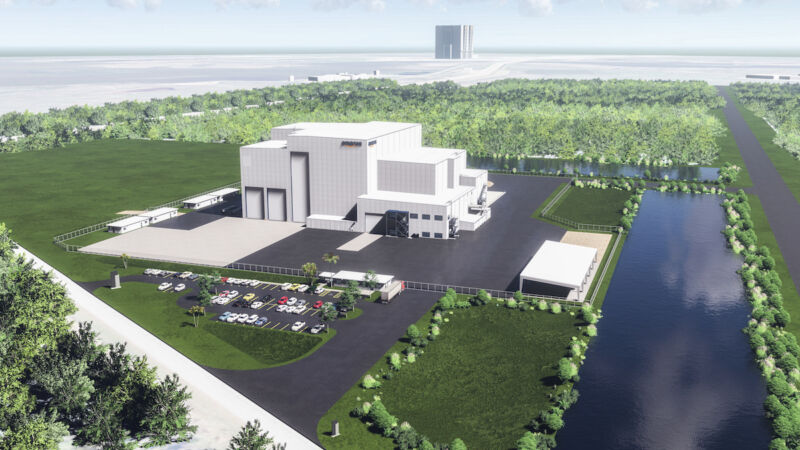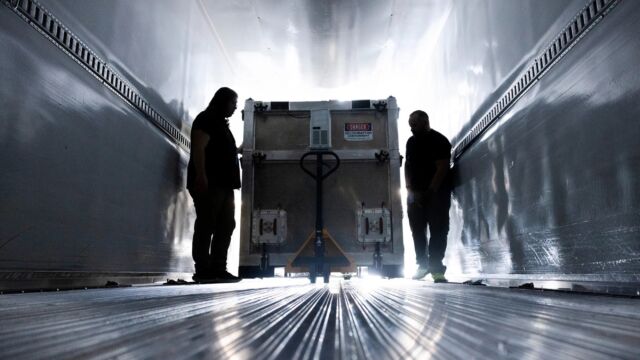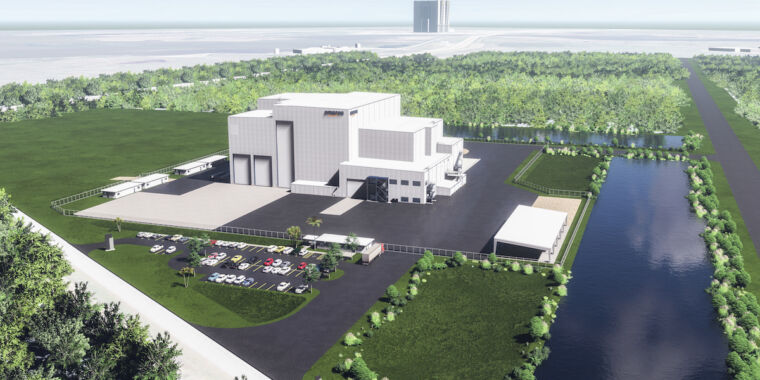
Within a few years, Amazon hopes to build and launch up to 80 satellites per month to populate the company’s Kuiper Constellation, a $10 billion network similar to fleets already operated by SpaceX and OneWeb that provide Internet connectivity around the world.
In the next six months, Amazon plans to begin production of operational Kuiper satellites at a new 17,000-square-foot facility in Kirkland, Washington. On Friday, officials from Amazon and the Florida government announced that a 100,000-square-foot facility under construction at NASA’s Kennedy Space Center will serve as a satellite processing facility for the Kuiper program.
At this facility near the old space shuttle runway, engineers will mount Kuiper satellites on massive orbital deployments that are several stories high, then encapsulate the structure in the nose cones of their rockets. The fully integrated payload bays will then be moved to launch pads operated by United Launch Alliance and Blue Origin – the aerospace company founded by Amazon founder Jeff Bezos – at Cape Canaveral Space Force Station, a few miles away.
The new structure will be built on land leased by NASA to Space Florida, a state-funded economic development agency focused on luring commercial space companies to the Sunshine State. It has a high bay that will be about 100 feet high, big enough to house the fairings of ULA and Blue Origin’s heavy-lift rockets. Amazon says it is investing about $120 million in the new facility, which can accommodate up to three simultaneous launch campaigns.
“One of the places that makes this facility so unique and such a great place to do business is its proximity to the launch providers and the launch sites,” said Brian Huseman, Amazon’s vice president of public policy.
Amazon’s Project Kuiper is one of many large “mega-constellations” already in space or nearing launch. It’s a competitor to SpaceX’s Starlink network, which already has more than 4,000 satellites in orbit, and OneWeb’s broadband constellation, which has more than 600 spacecraft.
If you follow this industry, you know that SpaceX regularly launches its Starlink satellites in large batches aboard the company’s own Falcon 9 rocket. These flights from Cape Canaveral and from Vandenberg Space Force Base, California, make up about half of SpaceX’s missions in recent years, with Starlink launches flying an average of about once a week.
Amazon’s projected launch rate is almost as ambitious. The company aims to deploy about half of its 3,236 satellites by July 2026, a deadline to maintain network authorization from the Federal Communications Commission. That would require at least two launches per month, and maybe more, from Amazon’s stable of launch service providers.
The expected launch cadence will require a special building to prepare the satellites for launch, Amazon officials said.

Last year, Amazon signed the largest commercial launch contract in history, making rides on ULA’s new Vulcan rocket, Blue Origin’s New Glenn and Arianespace’s Ariane 6 launcher. All told, Amazon has purchased 77 launches: 38 Vulcan launches, plus nine flights on ULA’s soon-to-retire Atlas V, 18 Ariane 6 missiles, and 12 New Glenn missions, with a contract option for another 15.
That will cover Kuiper’s launch service needs for its 3,200 satellites. But all those missiles, except the Atlas V, are still under development. ULA’s Vulcan appears to be flying first of Amazon’s crop of launchers, likely followed by the European-built Ariane 6 and then Blue Origin’s New Glenn.
SpaceX was not part of the launch contracts, which came as no surprise since Amazon’s Kuiper network will compete with Starlink. But OneWeb, another satellite broadband provider, signed a deal with SpaceX last year to launch its satellites on Falcon 9 rockets after launches on Russian rockets failed in the wake of Russia’s invasion of Ukraine.

